LA Orthopedic Emergencies
Nerve damage
Nerve damage may occur with direct trauma (laceration), indirect trauma (sharp end of a fractured bone), pinching by a fracture callus or scar tissue, or overstretching as when a leg it caught under a trailer or over a fence.
General treatment principles for nerve injuries include anti-inflammatory agents, supportive care and time. For limb injuries, treatment should include stall confinement with deep bedding. Sand is a good base as it is soft but provides stable footing. Steroids or NSAIDs are administered: dexamethasone @ 0.05 mg/kg, IM, every 1-2 days or flunixin meglumine @ 1 mg/kg, IM, q 12 h.
Hindlimb nerve injury
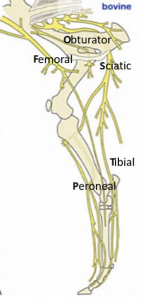 Many hindlimb nerve injuries are due to dystocia, particularly in cattle with oversized calves. Many result in “downer cows” or cattle unable to stand voluntarily.
Many hindlimb nerve injuries are due to dystocia, particularly in cattle with oversized calves. Many result in “downer cows” or cattle unable to stand voluntarily.
Obturator paralysis
Seem immediately after calving, obturator paralysis is often related to calf hip lock. Adductor muscles are affected. The animal will have a base wide stance or may not be able to stand without assistance. When the limb is placed properly, the animal can weight bear. The fetlocks may knuckle. Affected animals are prone to limb abduction, particularly on slippery surfaces. When sitting, the hindlimbs are often extended forward. Obturator paralysis can lead to hip dislocation.
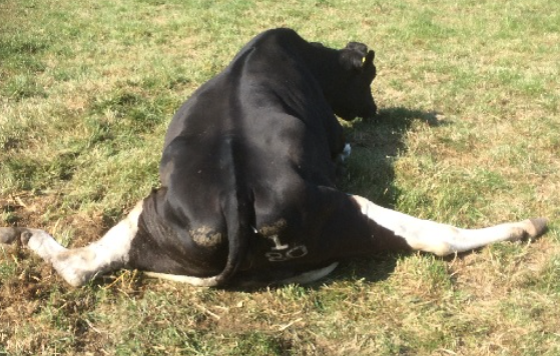
The animal should be moved to an area with good footing. Treatment may include hobbling the back legs to prevent the animal from doing the splits (use hobbles placed above the fetlocks). There is a high risk of permanent damage due to ongoing damage to muscles and nerves.
Ischiatic paralysis/sciatic nerve damage
Sciatic nerve damage is primarily seen immediately after calving but can be seen with hip fractures or injections. Persistent knuckling of fetlock and slight “dropping” of the hock is observed as the sciatic nerve innervates the muscles of the lower limb and is important in proprioception. Weight bearing is variably affected and may be due to other issues vs directly related to the sciatic nerve damage.
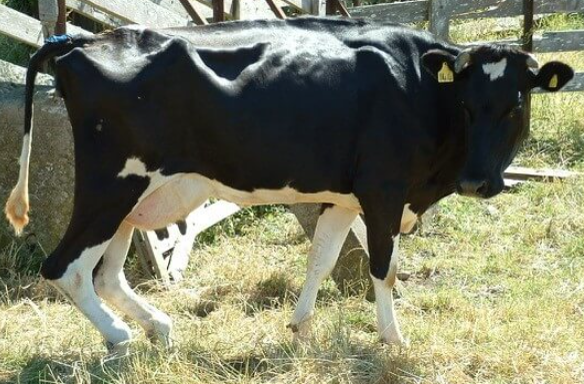
Tibial/peroneal nerve paralysis
Tibial/peroneal nerve paralysis is seen primarily in cattle immediately after parturition or prolonged recumbency and is due to pressure ischemia over lateral stifle region. The fetlocks are hyperflexed with some animals walking on the dorsum of the fetlock. The animal can bear weight on the limb but the hock is overextended and the digit cannot be extended. Both hindlimbs are typically involved when it is related to prolonged labor. A slightly milder version of sciatic nerve damage.
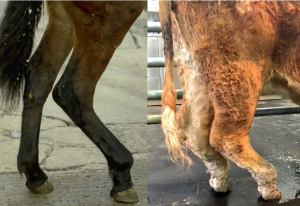
Treatment includes bandaging/splinting to straighten the fetlock. Differentials include gastrocnemius rupture (a larger hock drop is observed with gastrocnemius rupture). Recovery takes 2-3 months.
Femoral nerve damage
The femoral nerve may be damaged during dystocia; this is again most likely with hip lock but now the calf’s nerve is damaged. Due to loss of quadriceps function, the baby cannot extend the limb for weight bearing. The patella is slack. Differentials to consider include hip fracture (femoral capital epiphyseal fracture) and hip luxation.
Prognosis is fair (depends on severity) but colostrum management is essential. Muscles will atrophy rapidly. NSAIDs may be helpful.
Forelimb nerve injury
Sweeney
Sweeney is damaged to the nerve(s) around the scapula. Damage usually occurs due to pressure on the nerve or damage by fracture.
Radial nerve/brachial plexus injury
The brachial plexus or radial nerve is damaged when an animal or its forelimb is restrained and the animal struggles. It can also be seen with prolonged lateral recumbency. With damage, the elbow drops and the carpus and fetlock are maintained in partial flexion. Animals are unable to flex the shoulder or extend the lower part of the limb. Severe lameness or non-weight bearing lameness is present with toe dragging. The animal can bear weight if the limb is splinted into a straight position. Differentials include humeral or olecranon fractures.
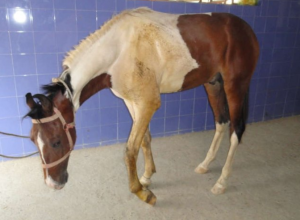
Treatment includes bandaging, splinting, or casting the leg (including carpal joint) to prevent fetlock abrasion.
Most forelimb nerve injuries will improve rapidly. Nerves regenerate slowly at ~1 inch/month. The closer the injury to the muscle it innervates, the better the prognosis. Muscles without nerve supply rapidly undergo atrophy so will need rehabilitation. It can take two years for full return to work.
If skin sensation is totally lost the prognosis is guarded. If the condition persists for more than 2 weeks, the damage is likely permanent.
Key Takeaways
Several types of nerve damage can occur with dystocia.
Obturator nerve damage leads to cows sitting in funny positions and can lead to hip luxations
Tibial/peroneal and sciatic nerve damage occur at different levels along the same nerve so look similar
Most nerve damage will improve with time and anti-inflammatory drugs. If no improvement is seen within 2 weeks, it may not ever improve.

